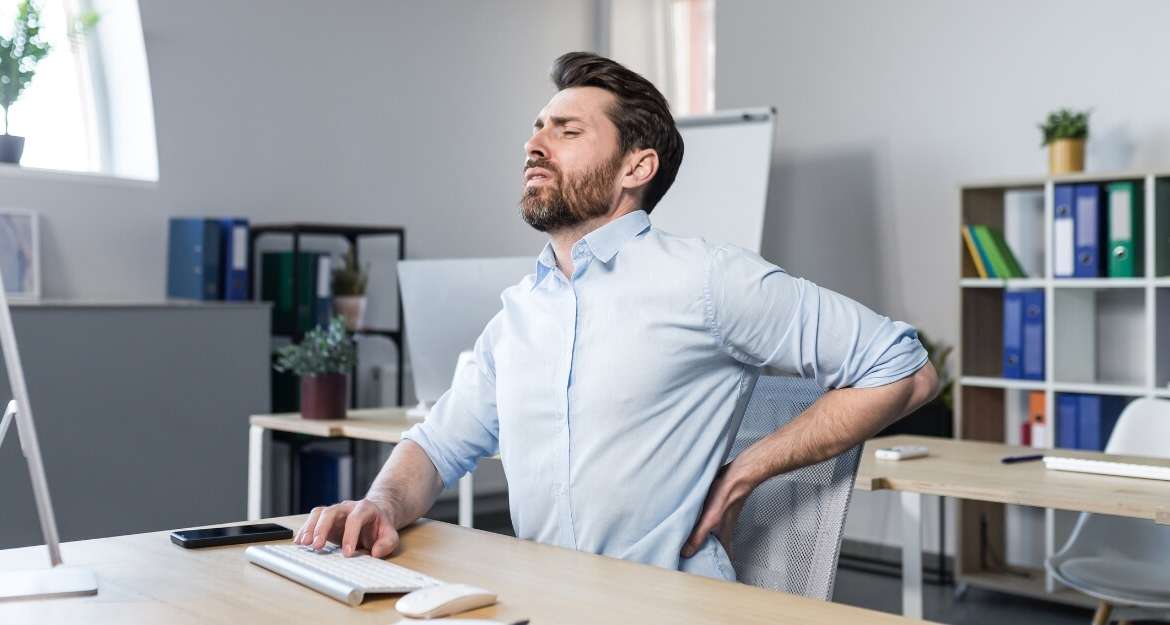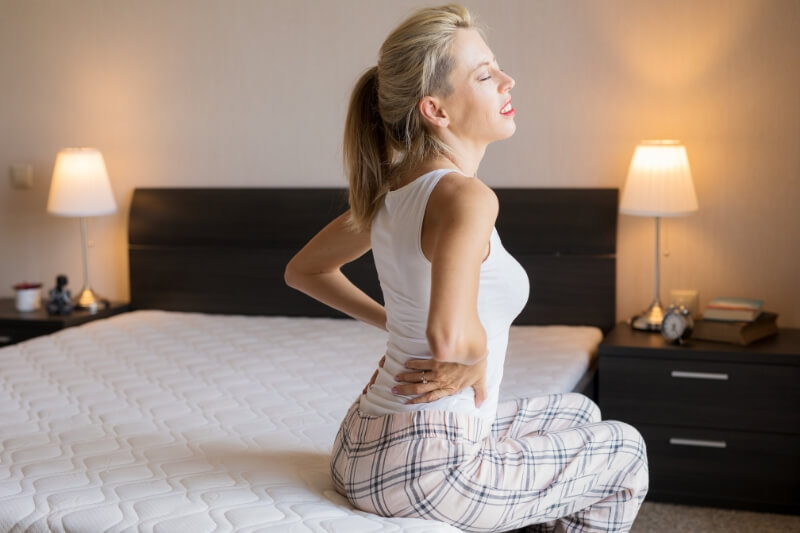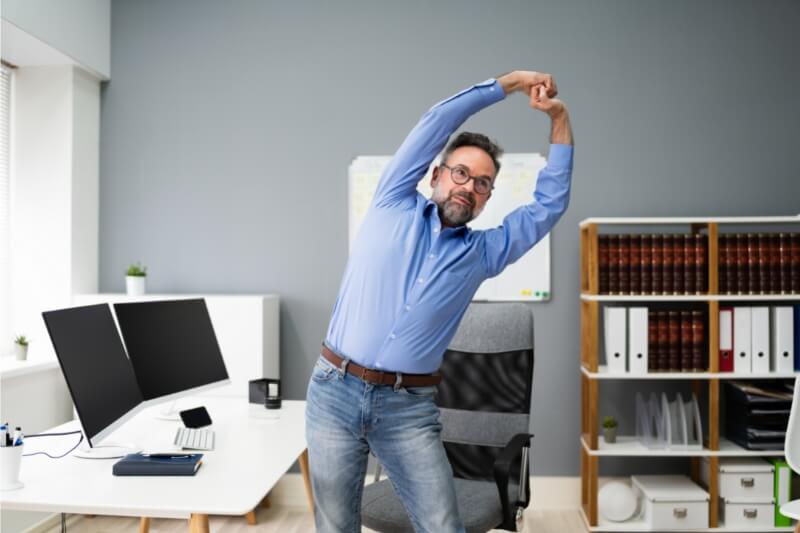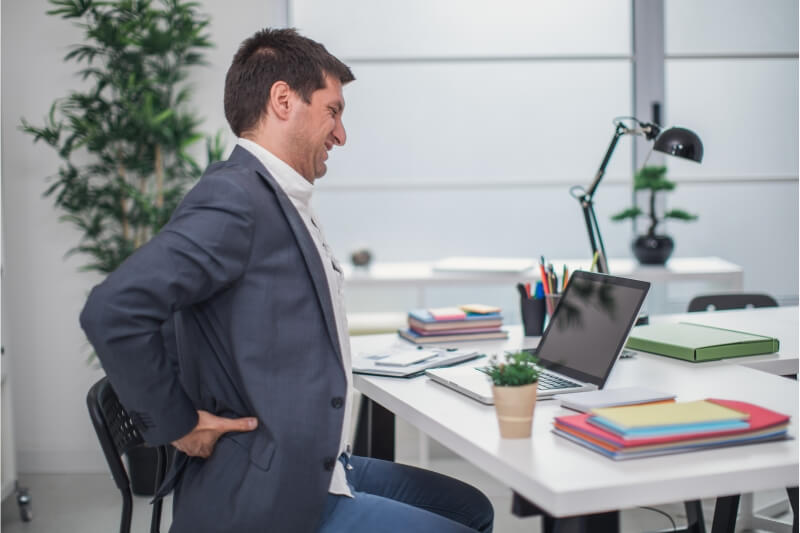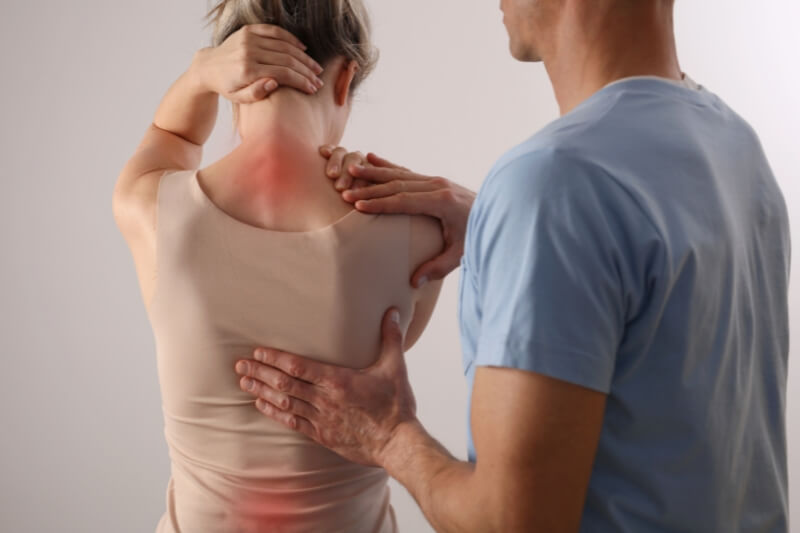Sitting for prolonged periods can lead to lower back pain and stiffness, making it difficult to perform daily activities.
With desk jobs being the norm in today’s world, it is essential to find ways to alleviate discomfort and promote a healthier work environment. In this article, we’ll discuss how to relieve back pain from sitting and provide tips and tricks to help reduce the likelihood of lower back pain.
The Negative Effects of Sitting for Long Periods of Time
Sitting for extended periods of time can cause low back pain and stiffness, leading to long-term health problems. Here are some of the most common negative effects of sitting for long periods:
- Low back pain
- Neck pain
- Shoulder pain
- Postural issues
- Poor sitting posture
- Incorrect sitting position
- Tight hips
- Decrease mobility of the spine and other joints
- Low energy levels
- Increased risk of obesity
- Increased risk of diabetes
- Increased risk of heart disease
What Causes Pain in Your Low Back From Sitting?
Several factors can contribute to low back pain from sitting. Here are a few of the most common:
- Poor posture
- Lack of movement
- Sitting in a chair that doesn’t provide proper support
- Sitting position
- Improperly positioned computer screen or keyboard
When a person has been sitting for a period of time, their spine moves into flexion (forward bending movement). Flexion movement may cause the posterior structures of the spine to be over-stretched or overstrained, synch as spinal ligaments, muscles and discs. This leads to decreased support and stability to the low back, which may result in disc bulge, herniated disc, disc prolapse, ligament sprains and muscle strains and fatigue. Over longer periods of time, this may result in more serious low back issues such as degenerative disc disease, stenosis on the spinal cord and/or spinal nerves from the disc.
Tips and Tricks to Relieve Pain in Your Low Back from Sitting
- Invest in a Good Chair: Choosing a good office chair is essential to maintaining good posture while sitting at a desk. Look for a chair with adjustable height, lumbar support, and a comfortable cushion. Your feet should be flat on the ground, and your arms should be at a 90-degree angle when typing. This can help prevent lower back stiffness after sitting and relieve pain. This should improve your poor sitting posture.
- Take Frequent Breaks: Frequent breaks from sitting can help alleviate your back pain. Try setting the alarm to remind you to get up and stretch every 30 minutes. Stand up, stretch your arms and legs, take a quick walk around the office, or do a few stretches. These simple movements can help prevent sitting back pain.
- Practice Good Posture: Sitting with good posture can help prevent low back pain. Sit with your feet flat on the ground, your back straight, and your shoulders relaxed. Your computer screen should be at eye level, and your keyboard and mouse should be within easy reach. This can help you sit and provide some pain relief for your lower back pain.
- Use a Standing Desk: Standing desks are becoming more popular in the workplace. Using a standing desk for part of the day can help alleviate low back pain caused by sitting. When using a standing desk, ensure your computer screen is at eye level, and your keyboard and mouse are within easy reach.
- Stretching Exercises: Stretching can help alleviate low back pain and prevent it from happening in the first place. Try some of these stretching exercises to help provide pain relief in for low back pain:
- Forward fold: stand with your feet hip-width apart, bend forward at the waist, and let your arms hang down toward the ground
- Cat-Cow: get on your hands and knees, arch your back up like a cat, and then drop your back down like a cow
- Child’s Pose: sit on your heels with your arms stretched out in front of you and rest your forehead on the ground
- Shoulder rolls: roll your shoulders forward and backwards and then up and down
- Hip flexors stretch: Kneel on one knee, with the other leg bent at a 90-degree angle in front. Keep the torso upright and push the hips forward until you feel a stretch in the front of the hip of the kneeling leg. Hold for 30 seconds and switch sides. This may provide some immediate pain relief in your low back.
- Use Heat or Ice Therapy: Applying heat or ice to your back can help alleviate pain. Try a heating pad or ice pack for 20 minutes at a time. Heat can help relax your muscles, while ice can reduce inflammation. This can help to reduce stiffness in the lower back after sitting.
- Improve Your Workspace: An ergonomic workspace can help prevent low back pain from sitting. Ensure your desk and chair are at the right height, your computer screen is at eye level, and your keyboard and mouse are within easy reach. Use a footrest if needed to ensure your feet are flat on the ground.
- Take Care of Your Lower Back: It is essential to take care of your lower back when sitting for prolonged periods. Ensure you have a good posture, move regularly, and stretch to prevent stiffness. Lumbar support, lumbar cushion or pillow can also provide extra support to your lower back.
- Avoid crossing your legs when sitting: keeps legs at 90 degrees; if you cross your legs, it can twist the spine and put more pressure on the low back.
- Stay Active: Regular exercise can help prevent low back pain from sitting. Try incorporating aerobic exercise, strength training, and stretching into your routine. Walking, swimming or yoga can be an excellent way to stay active and help alleviate low back pain.
- Get a regular treatment: Treatment from an osteopath or other allied health practitioner can help alleviate low back pain by promoting blood flow, improving mobility in joints and other connective tissues, and improving overall bad posture to take pressure off your load back.
- Practice Mindfulness: Stress can cause muscle tension, leading to low back pain. Practising mindfulness can help reduce stress levels and promote relaxation. Try mindfulness meditation or deep breathing exercises during the workday to reduce stress and improve focus.
How to Relieve Back Pain from Sitting at Your Desk
If you have a desk job, you are likely familiar with the pain and discomfort that can arise from sitting for prolonged periods. This can lead to back pain, stiffness, and even injury. In this article, we will explore the causes of back pain from sitting at a desk and provide remedies to help alleviate the discomfort.
Causes of Back Pain from Sitting at Your Desk:
- Incorrect Posture: Sitting with the wrong posture can put undue stress on your back and neck, leading to pain and discomfort. Slouching, hunching over your desk, or leaning to one side can contribute.
- Lack of Movement: Sitting in one position for an extended period can cause muscle tension, stiffness, and back pain. When we sit for prolonged periods, our muscles are not engaged, leading to a lack of circulation and reduced flexibility.
- Improper Sitting Position: Sitting in an improper position can also cause back pain. For instance, sitting in a chair that is too high or too low can cause strain on your back muscles. Similarly, sitting cross-legged or with crossed legs can cause misalignment and strain your back and hips.
- Lack of Physical Activity: A lack of physical activity can lead to weak muscles, overall posture, and reduced flexibility. Over time, this can contribute to back pain and discomfort.
Remedies for Back Pain from Sitting at Your Desk
- Sit with Proper Posture: To prevent back pain from sitting at your desk, sit with proper posture. Keep your back straight, shoulders relaxed, and feet flat on the floor. Use an ergonomic chair with good lumbar support for your lower back, and sit at a height that allows you to keep your arms and elbows at a 90-degree angle.
- Take Frequent Breaks: Frequent breaks from sitting can help prevent back pain. Stand up and stretch your legs, arms, and back every 30 minutes. Go for a quick walk or do a few stretches to keep your muscles engaged and prevent stiffness. Lie on a rolled-up towel on the floor during the break to help.
- Use a Footrest: If your feet don’t reach the floor when sitting, use a footrest to support your feet. This can help reduce pressure on your back and prevent stiffness.
- Consider Physical Therapy: If you experience chronic back pain, physical therapy can be a helpful option. A physical therapist can evaluate your posture and muscle strength and provide exercises and stretches to alleviate back pain. This may improve your overall bad posture.
- Engage in Physical Activity: Regular physical activity can help strengthen your back muscles and improve posture. Try incorporating aerobic exercise, strength training, and stretching into your routine. Walking, swimming or yoga can be an excellent way to stay active and prevent back pain.
Conclusion
Back pain from sitting at your desk is a common issue that affects many people. Poor posture, lack of movement, improper sitting position, and lack of physical activity can all contribute to back pain.
By following the remedies we’ve outlined, you can alleviate back pain and discomfort and improve your overall well-being. Remember to sit properly, take frequent breaks, use a footrest, consider physical therapy, and engage in physical activity to prevent back pain from sitting at your desk.
Contact our friendly osteo team at MOSIC to find the ideal recovery for your low back pain. We can help you prevent or recover from lower back pain when running for good!

